
Artist Profile: Maria Guleghina, A Fierce Dramatic Soprano
By David SalazarMaria Guleghina, born on August 9, 1959 in Odessa has had one of the great careers of the late 20th century.
The soprano studied at the Music Conservatory in her native city before eventually making a stage debut in 1985 at the State Opera in Minsk. But she had no intention of staying in the Soviet Union and would make her international debut just two years later alongside Luciano Pavarotti in “Un Ballo in Maschera” at La Scala. Her strong showing at the legendary theater soon earned her opportunities at the Vienna State Opera, Paris Opera, and in such German cities as Munich and Hamburg.
Then she landed her first Met performance in 1991 in “Andrea Chénier,” before appearing at the San Francisco Opera and Lyric Opera of Chicago. She would make her debut at the Mariinsky Theater in St. Petersburg in 1992 and would sing at the Winter Olympics in 2010. She also performed at the 2014 Paralympic Games in Sochi.
In addition to her work as a singer, she is also a member of the Honorary Board of the International Paralympic Committee.
Major Roles
Guleghina has dominated a number of roles, including that of Tosca and Leonora in “Il Trovatore.”
But her big roles were Abigaille in “Nabucco,” Lady Macbeth in “Macbeth” and the title role of “Turandot.”
Of her Abigaille at the Met back in 2001, the New York Times noted, “Maria Guleghina, who gives a fearless, exciting and dangerous performance. She fills the hall with gleaming sound, and in her disheveled blond wig has an amazing wild-eyed look. But the heavy-duty singing takes its toll, and in the few reflective moments, her voice is shaky. Still, Ms. Guleghina is the Abigaille of the day.”
Her Lady Macbeth was renowned for its violent edge, as was her interpretation of “Turandot,” Guleghina really giving her that icy quality.
Read More on Guleghina
Watch and Listen
Here is Guleghina in “Tosca.”
And here is a documentary on her career.
Categories
Opera Wiki

